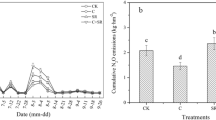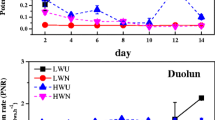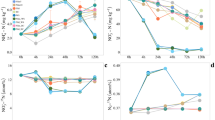Abstract
The response of nitrifier and denitrifier populations and associated N2O emissions to different carbon-to-nitrogen (C/N = 17 or 45) straw amendments was monitored under flooding-drying and non-flooding conditions. A 10-week laboratory mesocosm study was conducted in two soils, (i) a paddy soil with a long history of managed flooding-drying (CN), and (ii) a wheat cropping soil with no previous history of flooding (UK). We measured N2O fluxes and the abundances of ammonia-oxidizing archaea (AOA) and bacteria (AOB), nitrite reductase (nirK and nirS) genes, and nitrous oxide reductase (nosZI and nosZII) genes during flooding (4 weeks) and post-flooding (6 weeks). Straw addition enhanced N2O emissions, with higher fluxes apparent after incorporation of narrow C/N residues. Moreover, the impact of crop amendment on N2O emission was exacerbated when soil was under flooding-drying conditions. The abundances of nirS and nosZI genes in CN soil and AOA gene in UK soil were increased by straw amendment, with highest in narrow C/N straw amendments. Structural equation modeling showed that the impact of denitrifier gene abundance on the N2O flux was stronger than that of nitrifier gene abundance in the two soils, and significant correlations were observed between N2O fluxes and the consumption of DOC and NO3−, indicating that denitrification was the dominant N2O production pathway during the drying phase. The ratio of (nirS + nirK)/(nosZI + nosZII) in the narrow C/N amendment was greater than in the wide C/N treatment after flooding, suggesting that the straw C/N ratio had an effect on the capacity for N2O production via denitrification. We conclude that crop amendments with an appropriate C/N ratio could minimize N2O fluxes through regulating the denitrification process when soils are subjected to regular flooding and drying and also experiencing greater frequencies of flooding.






Similar content being viewed by others
References
Abalos D, Sanz-Cobena A, Garcia-Torres L, Van Groenigen JW, Vallejo A (2013) Role of maize Stover incorporation on nitrogen oxide emissions in a non-irrigated Mediterranean barley field. Plant Soil 364:357–371
Adair KL, Schwartz E (2008) Evidence that ammonia-oxidizing archaea are more abundant than ammonia-oxidizing bacteria in semiarid soils of northern Arizona, USA. Microb Ecol 56:420–426
AHBD Agriculture & Horticulture Development Board Badagliacca G, Ruisi P, Rees RM, Saia S (2017) An assessment of factors controlling N2O and CO2 emissions from crop residues using different measurement approaches. Biol Fertil Soils 53:547–561
Badagliacca G, Ruisi P, Rees RM, Saia S (2017) An assessment of factors controlling N2O and CO2 emissions from crop residues using different measurement approaches. Biol Fertil Soils 53(5):547–561
Barton L, Kiese R, Gatter D, Butterbach-Bahl K, Buck R, Hinz C, Murphy DV (2008) Nitrous oxide emissions from a cropped soil in a semi-arid climate. Glob Chang Biol 14:177–192
Beniston M, Stephenson DB, Christensen OB, Ferro CA, Frei C, Goyette S, Halsnaes K, Holt T, Jylhä K, Koffi B (2007) Future extreme events in European climate: an exploration of regional climate model projections. Clim Chang 81:71–95
Blake G, Hartge K (1986) Particle density Methods of soil analysis: part 1 physical and mineralogical methods. 5:377–382
Caporaso JG, Lauber CL, Walters WA, Berg-Lyons D, Lozupone CA, Turnbaugh PJ, Fierer N, Knight R (2011) Global patterns of 16S rRNA diversity at a depth of millions of sequences per sample. Proc Natl Acad Sci 108:4516–4522
Chen H, Li X, Hu F, Shi W (2013) Soil nitrous oxide emissions following crop residue addition: a meta-analysis. Glob Chang Biol 19:2956–2964
Chen L, Zhang J, Zhao B, Yan P, Zhou G, Xin X (2014) Effects of straw amendment and moisture on microbial communities in Chinese fluvo-aquic soil. J Soils Sediments 14:1829–1840
Cheng Y, Wang J, Wang J, Chang SX, Wang S (2017) The quality and quantity of exogenous organic carbon input control microbial NO3− immobilization: a meta-analysis. Soil Biol Biochem:357–363
Congreves K, Wagner-Riddle C, Si B, Clough T (2018) Nitrous oxide emissions and biogeochemical responses to soil freezing-thawing and drying-wetting. Soil Biol Biochem 117:5–15
Datta R, Vranová V, Pavelka M, Rejšek K, Formánek P (2014) Effect of soil sieving on respiration induced by low-molecular-weight substrates. Int Agrophys 28:119–124
Dobbie KE, Smith KA (2003) Nitrous oxide emission factors for agricultural soils in Great Britain: the impact of soil water-filled pore space and other controlling variables. Glob Chang Biol 9:204–218
FAO (2015) World reference base for soil resources 2014. World soil resources reports 106 Food and Agriculture Organization of the United Nations, Rome
Francis CA, Roberts KJ, Beman JM, Santoro AE, Oakley BB (2005) Ubiquity and diversity of ammonia-oxidizing archaea in water columns and sediments of the ocean. Proc Natl Acad Sci 102:14683–14688
Frimpong KA, Baggs E (2010) Do combined applications of crop residues and inorganic fertilizer lower emission of N2O from soil? Soil Use Manag 26:412–424
Gao J, Xie Y, Jin H, Liu Y, Bai X, Ma D, Zhu Y, Wang C, Guo T (2016) Nitrous oxide emission and denitrifier abundance in two agricultural soils amended with crop residues and urea in the North China Plain. PLoS One 11:e0154773
Hai B, Diallo NH, Sall S, Haesler F, Schauss K, Bonzi M, Assigbetse K, Chotte J-L, Munch JC, Schloter M (2009) Quantification of key genes steering the microbial nitrogen cycle in the rhizosphere of sorghum cultivars in tropical agroecosystems. Appl Environ Microbiol 75:4993–5000
Harrison-Kirk T, Beare M, Meenken E, Condron L (2013) Soil organic matter and texture affect responses to dry/wet cycles: effects on carbon dioxide and nitrous oxide emissions. Soil Biol Biochem 57:43–55
Harter J, Krause HM, Schuettler S, Ruser R, Fromme M, Scholten T, Kappler A, Behrens S (2014) Linking N2O emissions from biochar-amended soil to the structure and function of the N-cycling microbial community. ISME J 8:660
Hartmann M, Frey B, Mayer J, Mäder P, Widmer F (2015) Distinct soil microbial diversity under long-term organic and conventional farming. ISME J 9:1177
Henry S, Baudoin E, López-Gutiérrez JC, Martin-Laurent F, Brauman A, Philippot L (2004) Quantification of denitrifying bacteria in soils by nirK gene targeted real-time PCR. J Microbiol Methods 59:327–335
Henry S, Bru D, Stres B, Hallet S, Philippot L (2006) Quantitative detection of the nosZ gene, encoding nitrous oxide reductase, and comparison of the abundances of 16S rRNA, narG, nirK, and nosZ genes in soils. Appl Environ Microbiol 72:5181–5189
Hu HW, Chen D, He JZ (2015) Microbial regulation of terrestrial nitrous oxide formation: understanding the biological pathways for prediction of emission rates. FEMS Microbiol Rev 39:729–749
Huang Y, Zou J, Zheng X, Wang Y, Xu X (2004) Nitrous oxide emissions as influenced by amendment of plant residues with different C: N ratios. Soil Biol Biochem 36:973–981
IPCC (2013) Climate change 2013: the physical science basis. Cambridge University Press, Cambridge
Jones CM, Graf DR, Bru D, Philippot L, Hallin S (2013) The unaccounted yet abundant nitrous oxide-reducing microbial community: a potential nitrous oxide sink. ISME J 7:417–426
Kettler T, Doran JW, Gilbert T (2001) Simplified method for soil particle-size determination to accompany soil-quality analyses. Soil Sci Soc Am J 65:849–852
Kowalchuk GA, Stephen JR (2001) Ammonia-oxidizing bacteria: a model for molecular microbial ecology. Annu Rev Microbiol 55:485–529
Li X, Hu F, Shi W (2013) Plant material addition affects soil nitrous oxide production differently between aerobic and oxygen-limited conditions. Appl Soil Ecol 64:91–98
Lin Y, Ding W, Liu D, He T, Yoo G, Yuan J, Chen Z, Fan J (2017) Wheat straw-derived biochar amendment stimulated N2O emissions from rice paddy soils by regulating the amoA genes of ammonia-oxidizing bacteria. Soil Biol Biochem 113:89–98
Macdonald CA, Clark IM, Hirsch PR, Zhao F-J, McGrath SP (2011) Development of a real-time PCR assay for detection and quantification of Rhizobium leguminosarum bacteria and discrimination between different biovars in zinc-contaminated soil. Appl Environ Microbiol 77:4626–4633
MacKenzie A, Fan M, Cadrin F (1998) Nitrous oxide emission in three years as affected by tillage, corn-soybean-alfalfa rotations, and nitrogen fertilization. J Environ Qual 27:698–703
Marsden KA, Jones DL, Chadwick DR (2017) DMPP is ineffective at mitigating N2O emissions from sheep urine patches in a UK grassland under summer conditions. Agric Ecosyst Environ 246:1–11
Martins CS, Nazaries L, Macdonald CA, Anderson IC, Singh BK (2015) Water availability and abundance of microbial groups are key determinants of greenhouse gas fluxes in a dryland forest ecosystem. Soil Biol Biochem 86:5–16
Miller M, Zebarth B, Dandie C, Burton D, Goyer C, Trevors J (2008) Crop residue influence on denitrification, N2O emissions and denitrifier community abundance in soil. Soil Biol Biochem 40:2553–2562
Miranda KM, Espey MG, Wink DA (2001) A rapid, simple spectrophotometric method for simultaneous detection of nitrate and nitrite. Nitric Oxide 5:62–71
Nannipieri P, Penton C, Purahong W, Schloter M, van Elsas J (2019) Recommendations for soil microbiome analyses. Biol Fertil Soils 55:765–766
Nguyen TT, Marschner P (2016) Soil respiration, microbial biomass and nutrient availability in soil after repeated addition of low and high C/N plant residues. Biol Fertil Soils 52:165–176
Qin H, Tang Y, Shen J, Wang C, Chen C, Yang J, Liu Y, Chen X, Li Y, Hou H (2018) Abundance of transcripts of functional gene reflects the inverse relationship between CH4 and N2O emissions during mid-season drainage in acidic paddy soil. Biol Fertil Soils 54:885–895
Rasmussen R (2001) Quantification on the LightCycler. Rapid cycle real-time PCR. Springer, Berlin, pp 21–34
Ravishankara A, Daniel JS, Portmann RW (2009) Nitrous oxide (N2O): the dominant ozone-depleting substance emitted in the 21st century. Science 326:123–125
Rotthauwe JH, Witzel KP, Liesack W (1997) The ammonia monooxygenase structural gene amoA as a functional marker: molecular fine-scale analysis of natural ammonia-oxidizing populations. Appl Environ Microbiol 63:4704–4712
Sánchez-Rodríguez AR, Hill PW, Chadwick DR, Jones DL (2017) Crop residues exacerbate the negative effects of extreme flooding on soil quality. Biol Fertil Soils 53:751–765
Sánchez-Rodríguez AR, Chadwick DR, Tatton GS, Hill PW, Jones DL (2018) Comparative effects of prolonged freshwater and saline flooding on nitrogen cycling in an agricultural soil. Appl Soil Ecol 125:56–70
Sánchez-Rodríguez AR, Nie C, Hill PW, Chadwick DR, Jones DL (2019) Extreme flood events at higher temperatures exacerbate the loss of soil functionality and trace gas emissions in grassland. Soil Biol Biochem 130:227–236
Schiermeier Q (2011) Increased flood risk linked to global warming. Nature Publishing Group, City, State
Senbayram M, Chen R, Mühling KH, Dittert K (2009) Contribution of nitrification and denitrification to nitrous oxide emissions from soils after application of biogas waste and other fertilizers. Rapid Commun Mass Spectrom 23:2489–2498
Sengupta A, Dick WA (2015) Bacterial community diversity in soil under two tillage practices as determined by pyrosequencing. Microb Ecol 70:853–859
Song K, Lee SH, Mitsch WJ, Kang H (2010) Different responses of denitrification rates and denitrifying bacterial communities to hydrologic pulsing in created wetlands. Soil Biol Biochem 42:1721–1727
Sun X, Han X, Ping F, Zhang L, Zhang K, Chen M, Wu W (2018) Effect of rice-straw biochar on nitrous oxide emissions from paddy soils under elevated CO2 and temperature. Sci Total Environ 628:1009–1016
Thomson AJ, Giannopoulos G, Pretty J, Baggs EM, Richardson DJ (2012) Biological sources and sinks of nitrous oxide and strategies to mitigate emissions. R Soc
Throbäck IN, Enwall K, Jarvis Å, Hallin S (2004) Reassessing PCR primers targeting nirS, nirK and nosZ genes for community surveys of denitrifying bacteria with DGGE. FEMS Microbiol Ecol 49:401–417
Vestergaard G, Schulz S, Schöler A, Schloter M (2017) Making big data smart—how to use metagenomics to understand soil quality. Biol Fertil Soils 53:479–484
Wagg C, Bender SF, Widmer F, van der Heijden MG (2014) Soil biodiversity and soil community composition determine ecosystem multifunctionality. Proc Natl Acad Sci 111:5266–5270
Whelan JA, Russell NB, Whelan MA (2003) A method for the absolute quantification of cDNA using real-time PCR. J Immunol Methods 278:261–269
Wilson J, Baldwin D, Rees G, Wilson B (2011) The effects of short-term inundation on carbon dynamics, microbial community structure and microbial activity in floodplain soil. River Res Appl 27:213–225
Xu X, Ran Y, Li Y, Zhang Q, Liu Y, Pan H, Guan X, Li J, Shi J, Dong L (2016) Warmer and drier conditions alter the nitrifier and denitrifier communities and reduce N2O emissions in fertilized vegetable soils. Agric Ecosyst Environ 231:133–142
Yang L, Zhang X, Ju X (2017) Linkage between N2O emission and functional gene abundance in an intensively managed calcareous fluvo-aquic soil. Sci Rep 7:43283
Yuan Y, Dai X, Xu M, Wang H, Fu X, Yang F (2015) Responses of microbial community structure to land-use conversion and fertilization in southern China. Eur J Soil Biol 70:1–6
Zhang W, Liang C, Kao-Kniffin J, He H, Xie H, Zhang X (2017) Effects of drying and wetting cycles on the transformations of extraneous inorganic N to soil microbial residues. Sci Rep 7:9477
Zhang Y, Ding H, Zheng X, Cai Z, Misselbrook T, Carswell A, Müller C, Zhang J (2018) Soil N transformation mechanisms can effectively conserve N in soil under saturated conditions compared to unsaturated conditions in subtropical China. Biol Fertil Soils 54:495–507
Zhao B, Zhang J, Yu Y, Karlen DL, Hao X (2016) Crop residue management and fertilization effects on soil organic matter and associated biological properties. Environ Sci Pollut Res 23:17581–17591
Zhong L, Du R, Ding K, Kang X, Li FY, Bowatte S, Hoogendoorn CJ, Wang Y, Rui Y, Jiang L, Wang S (2014) Effects of grazing on N2O production potential and abundance of nitrifying and denitrifying microbial communities in meadow-steppe grassland in northern China. Soil Biol Biochem:1–10
Zhou W, Lin S, Wu L, Zhao JS, Wang ML, Zhu B, Mo YL, Hu RG, Chadwick D, Shaaban M (2017) Substantial N2O emission during the initial period of the wheat season due to the conversion of winter-flooded paddy to rice-wheat rotation. Atmos Environ 170:269–278
Acknowledgments
This study was financed by UK-China Virtual Joint Centre for Agricultural Nitrogen (CINAg) funded by the Newton Fund via UK BBSRC/NERC (BB/N013468/1). We would like to thank the Bangor University, Rothamsted Research, and China Scholarship Council which supported the research in the UK.
Author information
Authors and Affiliations
Corresponding author
Additional information
Publisher’s note
Springer Nature remains neutral with regard to jurisdictional claims in published maps and institutional affiliations.
Electronic supplementary material
ESM 1
(DOCX 142 kb)
Rights and permissions
About this article
Cite this article
Zhou, W., Jones, D.L., Hu, R. et al. Crop residue carbon-to-nitrogen ratio regulates denitrifier N2O production post flooding. Biol Fertil Soils 56, 825–838 (2020). https://doi.org/10.1007/s00374-020-01462-z
Received:
Revised:
Accepted:
Published:
Issue Date:
DOI: https://doi.org/10.1007/s00374-020-01462-z




